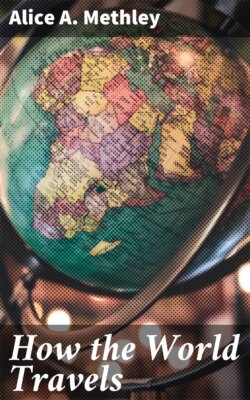Читать книгу How the World Travels - Alice A. Methley - Страница 5
На сайте Литреса книга снята с продажи.
CHAPTER III
STRANGE VEHICLES OF EUROPE
ОглавлениеTable of Contents
It is not only in the far-away countries of the world that we must travel in order to discover curious conveyances. Some are to be seen quite near at home, even in England itself. We must remember that as a rule it is because things are unfamiliar that they seem quaint and curious, so let us try to imagine for a few moments that we are natives of some distant land who have come to pay a visit to Great Britain.
We land at Dover, perhaps, or Newhaven, and go along the coast until we come to Brighton. It is quite a commonplace seaside town, no doubt, but, in our characters of observant foreigners, we shall notice many interesting things, and among them are several extraordinary little vehicles which are drawn up in a row along the parade.
What can they be, these tiny carriages, each with its wheels, shafts, and box-seat complete? Then we see that instead of a pony or donkey, the little conveyances are drawn by shaggy, long-horned goats.
SEASIDE CARRIAGE DRAWN BY GOAT.
The stranger stares with amusement at the dainty goat-chaises as they drive away filled with merry loads of children. Then he travels up to London and goes for a stroll in one of the poorer districts of the great city.
It is a Bank Holiday perhaps, or a fine Saturday in the summer-time, and the costermongers are off in their donkey-carts for a day's outing on Hampstead Heath. What a noise and clatter there is as the heavily laden little vehicles trot past, the donkeys looking so smart with their well-groomed coats and bright harness, and the drivers in the festive costumes decorated with pearl buttons that, surely, no foreign city in the world can rival!
We leave Whitechapel or the Old Kent Road behind us now, and journey out into the country, where, in some narrow green lane or on a breezy common, we overtake a yellow-painted gipsy van, hung about with baskets and brooms, and drawn by a sturdy, sleepy old horse. The owner of the van walks at his horse's head, or sits comfortably on the shaft, and through a little muslin-curtained window we catch a glimpse of his wife's dark face and long earrings. The gipsy children, ragged, bright-eyed urchins, lag behind, gathering flowers from the hedges, or run through the dust of the road to beg for pennies.
Certainly England has its own share of strange vehicles, and there are others even more curious still to be seen in out-of-the-way districts. One of these is the two-wheeled cart used for farm-work in some parts of Wales, which, in shape, is almost exactly like the ancient chariots that were found in Britain by the Roman invaders when they landed between Walmer and Sandwich nearly two thousand years ago.
Across St. George's Channel the quaint-looking Irish jaunting car is to be found, and then we travel back again to the continent of Europe. If we landed at Ostend or Antwerp before the War, most likely the first thing we should have seen would be a neat little cart loaded with vegetables or bright milk-cans, and harnessed to one or two large handsome dogs.
In England most dogs, except those owned by farmers or sportsmen, lead idle lives, but this is not the case on the Continent. The dogs of Belgium, Holland, and Germany are quite content to work—and to work hard, too—for their livings. There are numbers of them in the towns and villages, bravely dragging heavy loads, or lying down between the shafts and taking a well-earned nap in some shady corner of the cobbled street.
BELGIAN DOG-DRAWN CART.
In Belgium dogs were employed, not only for peaceful purposes, but in times of war for drawing ambulances, little ammunition wagons, and machine-guns.
SEDAN CHAIR, CONSTANTINOPLE.
Oxen are also used to draw carts in most of the European countries, and very picturesque some of them are. In Turkey most elaborate bullock carts are used in some districts as mourning carriages, and in them women are conveyed when they wish to visit the grave-yards. These carts are usually drawn by two animals which wear, fixed to their collars, large curved pieces of wood hung with tassels. The carts themselves are elaborately decorated, and while one man leads the bullocks another, staff in hand, walks at the side of the vehicle.
TURKISH MOURNING CAR.
There are many other strange conveyances to be seen in Turkey, perhaps the most curious of all being the sedan chairs which, although they have quite disappeared from other cities of Europe, are still used at night or on snowy days in the streets of Constantinople. In the eighteenth century sedan chairs were common in England, and in them the powdered and patched ladies went to their balls and routs, but it is strange to think of the quaint old-world conveyances being carried by stalwart Turkish porters along the dark, muddy streets of an Oriental city. These chairs, like the agricultural carts of Wales, come down to us from a past age, and another strange survival is seen at Schiessel, a village near Bremen, where the peasant girls drive to weddings and other festivities in large wagons that, painted and decorated with garlands of flowers, are exactly like the old carts and charettes of the Middle Ages.
Russia is a country where the carriages appear very strange to English eyes, for there three horses are driven abreast, and while the two outer animals gallop, the one in the centre is trained to trot. As may be imagined, a very skilful and experienced driver is necessary to guide these droskeys, as they are called, along the rough country roads or through the crowded streets of a city.
